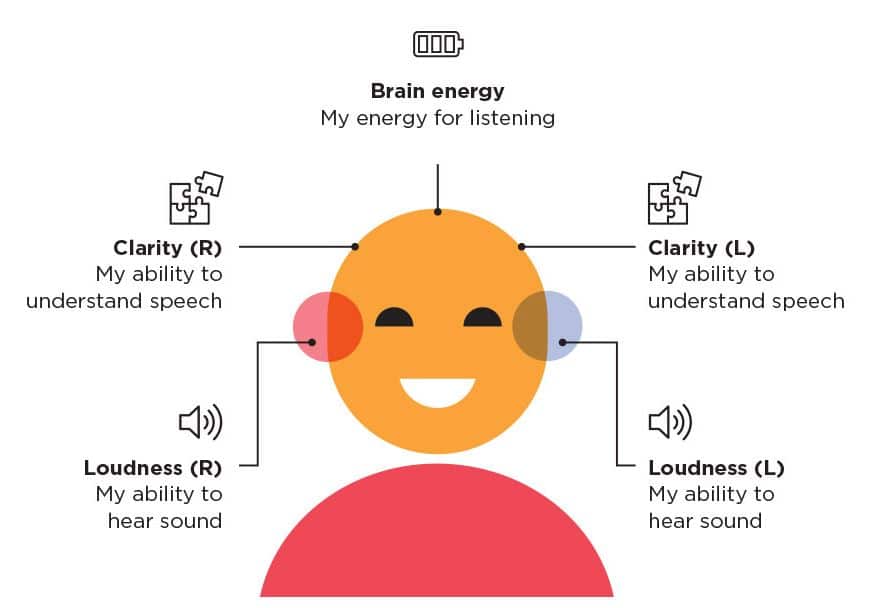by Lise Lotte Bundesen

Lise Lotte Bundesen
The future of hearing care won’t just be about technology. More than ever, people with hearing loss want to understand their condition and be involved in decisions about their care.
But many find the audiogram – that fundamental audiological tool – difficult to understand, leaving them disempowered and disillusioned.
A new tool from the Ida Institute enables hearing care professionals to cut through the complexity of the audiogram, translate its vital insights into everyday language, and provide the person-centered experience that growing numbers of clients want.
My Hearing Explained is a free, editable, one-page conversation guide. There are versions for online and in-person appointments, and for adults and children.
The tool doesn’t replace the audiogram, but supplements it, enabling professionals to explain a person’s hearing loss to them in language that’s easy to understand and easy to relay to family and friends.
“Usually I jump to technology straight away,” said one audiologist after trying out the tool. “This reminds me that there are other hearing strategies. The tech will not do the magic itself – there are other things, other strategies, and this gives the patients a good mindset from the beginning.”
The free tool can also save time in appointments: “I only took four minutes instead of ten to explain the results,” said one professional. “In these few minutes I covered everything – the technology, the problem, the explaining of the issue.”
A ‘Revelatory’ Hearing Care Tool
My Hearing Explained was developed with hearing care professionals from the US, UK, Australia, New Zealand, and South Africa, and tested with audiologists and clients around the world. It comprises three elements:
- a visual with icons representing loudness, clarity, and brain energy to help explain how hearing works and open a conversation about the client’s own hearing problems
- a series of questions that help the professional access key information about what the client can hear, what they struggle with, and their most important communication situations
- a summary section for the professional to note their recommendations for technology, assistive devices, and communication strategies.
After experiencing the tool for the first time, one client described it as “revelatory:”
“It’s far more human and interactive than just being told, ‘this is your audiogram, off you go, we’ll give you some aids,’” she said. “Now it’s not just a laboratory result – it has explained the things I was aware of but hadn’t figured out for myself.”

My Hearing Explained is a conversation guide for relaying hearing test results in person-centered terms.
Going beyond the audiogram
While the audiogram is an indispensable tool to measure and document a person’s hearing loss, research has long shown that it’s not the best tool to help the person understand it.
In 2018, the Ida Institute set out to dig deeper, working with hearing care professionals, clients, and academics around the world.
We found that, on average, people understood just over half of what they were told when their test results were explained via the audiogram, and were even less confident about relaying that information to family and friends.
Many professionals were also unhappy with the status quo. Asked if they would like new tools or methods for communicating to their clients about their hearing loss and its impact on daily life, 99% answered “yes.”
An intensive innovation process, involving these same groups of stakeholders, led to the creation of My Hearing Explained. An equally intensive testing and refining process followed, plus the development of a pediatric version, which was rated highly by professionals and children with hearing loss during the testing process.
‘Addresses the client’s needs and concerns one by one’
Of course, not every client will benefit. Our research found that some people appreciate a detailed explanation based on the audiogram, while others just want to know what can be done about their hearing loss.
However, where a client wants to understand but is finding it difficult to process the complex information, My Hearing Explained is a helpful tool that can be used in myriad ways, the approach tailored to the individual.
“This tool will force you to be person-centered,” said one audiologist after using it extensively. “It is not possible to have your own agenda, and you can’t take decisions on behalf of the client. It addresses the client’s needs and concerns one by one.”
Clients today want to feel informed and to have their unique preferences, needs, and values taken into account. Tools such as My Hearing Explained help professionals deliver this care and empower people to understand, communicate, and take control of their hearing loss.
Ready to learn more about how to implement the My Hearing Explained tool in the clinic? Don’t miss the presentation by Dr. Ena Nielsen at the Future of Hearing Healthcare Conference on March 18th at 10:05am EST
Lise Lotte Bundesen is the Managing Director of the Ida Institute – an independent, non-profit organization working with hearing care professionals and patients from around the world to develop and integrate person-centered pratice in hearing care. Ms. Bundesen was the architect behind the creation of the institute in 2007. She has extensive experience in the fields of communication, education/training, ethics and social responsibility and has worked in the health-care arena for many years, specifically for the multinational company Novo Nordisk.







